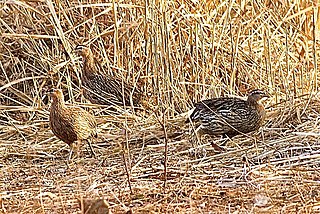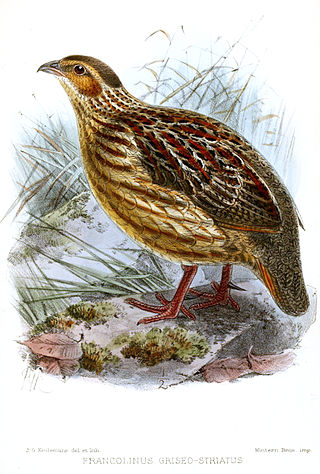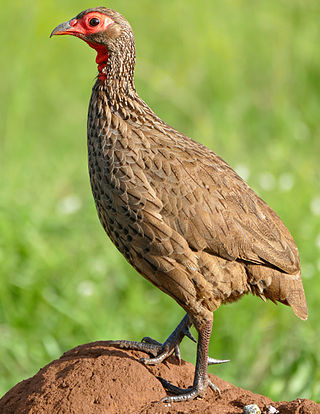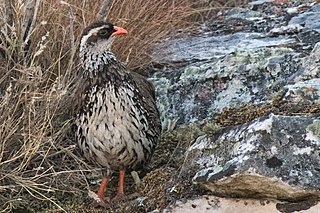
The double-spurred spurfowl is a gamebird in the pheasant family Phasianidae of the order Galliformes, gallinaceous birds. Like most spurfowls, it is restricted to Africa. It is a resident breeder in tropical west Africa, but there is a small and declining isolated population in Morocco.

The red-necked spurfowl or red-necked francolin, is a gamebird in the pheasant family Phasianidae that is a resident species in southern Africa.

The handsome spurfowl is a species of bird in the pheasant family Phasianidae. It is a large, up to 35 cm long, terrestrial forest bird with a dark reddish brown plumage, grey head, red bill and legs, brown iris, bare red orbital skin and rufous grey below. Both sexes are similar. The female is slightly smaller than male. The young has duller plumage.

The Cape spurfowl or Cape francolin is a gamebird in the pheasant family Phasianidae. It is endemic to southern Africa, where it is the largest francolin. It occurs in the Western Cape province of South Africa, and locally northwards to southern Namibia. It has adapted to alien vegetation and a variety of human-altered habitats, but scrubby roosting and nesting space is a prerequisite. The species is not threatened.

The red-billed spurfowl, also known as the red-billed francolin, is a species of bird in the family Phasianidae. It is found in Southern Africa, including Angola, Botswana, Namibia, South Africa, Zambia, and Zimbabwe.

The Ahanta francolin or Ahanta spurfowl is a species of bird in the pheasant family, Phasianidae. It is native to western Africa, where it occurs in Benin, Ivory Coast, Gambia, Ghana, Guinea, Guinea-Bissau, Liberia, Mali, Nigeria, Senegal, Sierra Leone, and Togo.

The chestnut-naped spurfowl is a species of bird in the pheasant family Phasianidae. At 33–37 cm (13–15 in) in length and weighing 550–1,200 g (19–42 oz), it is a large species of spurfowl. It is found in Ethiopia and Somaliland. The population is believed to be stable but according to the International Union for Conservation of Nature (IUCN) there is insufficient data to make an estimate of the population.

Clapperton's spurfowl is a species of bird in the family Phasianidae. It is found in Cameroon, Central African Republic, Chad, Eritrea, Ethiopia, Mali, Mauritania, Niger, Nigeria, Sudan, and Uganda.

Erckel's spurfowl, also known as Erckel's francolin, is a species of game bird in the family Phasianidae.

The grey-striped spurfowl is a species of bird in the family Phasianidae. It is found only in Angola.

Harwood's spurfowl, also known as Harwood's Francolin, is a species of bird in the family Phasianidae. It is a grey-brown bird with red bill and tail, and red bare skin around the eyes. Both sexes have similar coloring, although the female is paler in color with a more extensive buff belly.

Hildebrandt's spurfowl is a species of bird in the family Phasianidae. It is found in Burundi, Democratic Republic of the Congo, Kenya, Malawi, Mozambique, Rwanda, Tanzania, and Zambia. The species is named for Johann Maria Hildebrandt, who collected the first specimens in Kenya. The sexes differ markedly in their plumage and females are smaller than males.

Heuglin's spurfowl is a species of bird in the family Phasianidae. It is found in Central African Republic, Democratic Republic of the Congo, South Sudan, and Uganda. The German explorer Theodor von Heuglin first described the species.

Jackson's spurfowl or Jackson's francolin is a species of bird in the family Phasianidae. It is found in Kenya and Uganda. Its preferred habitats include mountainous forests and stands of bamboo.

The yellow-necked spurfowl or yellow-necked francolin is a species of bird in the family Phasianidae. It is found in Djibouti, Eritrea, Ethiopia, Kenya, Somalia, Sudan, Tanzania, and Uganda. This species is named for the yellow patch found on its neck. Males of this species have been noted to have spurs on the back of their legs.

The Natal spurfowl or Natal francolin is a species of bird in the family Phasianidae. It is found in Botswana, Eswatini, Mozambique, South Africa, Zambia, and Zimbabwe.

The scaly spurfowl is a species of bird in the family Phasianidae. It is found in Angola, Burundi, Cameroon, Central African Republic, Republic of the Congo, Democratic Republic of the Congo, Equatorial Guinea, Ethiopia, Gabon, Kenya, Malawi, Nigeria, Rwanda, São Tomé and Príncipe, Sudan, Tanzania, and Uganda.

Swainson's spurfowl or Swainson's francolin is a species of bird in the family Phasianidae which is native to Southern

Swierstra's spurfowl is a species of bird in the family Phasianidae. It is found only in Angola in the rapidly shrinking Afromontane forests of peaks such as Mount Moco and Mount Soque.

Pternistis is a genus of galliform birds formerly classified in the spurfowl group of the partridge subfamily of the pheasant family. They are described as "partridge-francolins" in literature establishing their phylogenetic placement outside the monophyletic assemblage of true spurfowls. All species are endemic to Sub-Saharan Africa, excepted the double-spurred spurfowl. They are commonly known as spurfowls or francolins, but are closely related to jungle bush quail, Alectoris rock partridges, and Coturnix quail. The species are strictly monogamous, remaining mated indefinitely. They procure most of their food by digging. Spurfowls subsist almost entirely on roots, beans of leguminous shrubs and trees, tubers, and seeds, and feasting opportunistically on termites, ants, locusts, flowers, and fruit. Important predators are jackals, caracals, servals, and birds of prey, as well as herons and marabou storks.




















